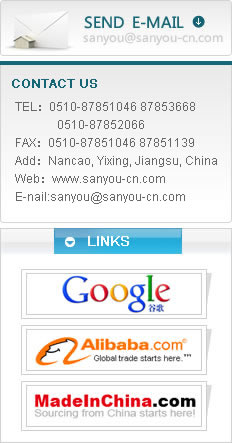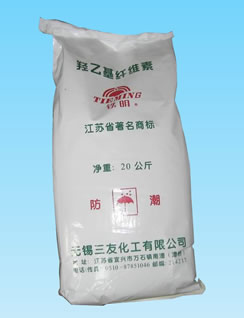Products
Hydroxyethyl cellulose(HEC). Possesses trustworthy properties in respects
of thickness promotion, enulsification, suspension, dispersion, cohesion,
moisture-keeping and anti-microbic fuction etc. Sanyou Chemical Co.,Ltd
is at present the largest HEC production base at home, the corporation
can provide surface-treated and untreated TF-series, different kinds
of HEC with various viscosities, which finds wide applicalions in suspension
polystyrene, foamable polystyrene, emulsion and new-type acrylic resin
emulsion paint, colorful paint, ion exchange resin, daily-use chemicals
and such departments as well drilling in oil fields, building materical,
textile, printing and dyeing and mintage machining etc. providing good
properties inf thickness promotion, emulsification, suspension, dispersion,
moisture-keeping and anti-microbic function etc.
Chemical property of HEC
HEC consists of two parts, one is cellulose, the other is hydroxyethyl side chain, HEC itself does not dissolve in water and is composed of numerous monose units, as illrstrated in figure(1), reaction of purified cellulose with sodium hydroxide produces alkaline cellulose colloids, put epoxyethane ito the colloide, HEC can be obtained. Since a monose unit of cellulose contains 3 hydroxies, the maximum replacement value should be 3. Nowaday, the replacement value of HEC is controlled between 1 and 2 on average, at the same time, the applied amount of epoxyethane is also controlled at 2 grammoles versus a monose unit, that is to say, on average one monose unit reacts with 2grammoles of epoxyethane, which may be joined togegher, a head with another’s tail, and then connected to a hydoxy or to two hydroxides respectively, as illustrated in figure(2)Fig(1):the structural drawing of collulose.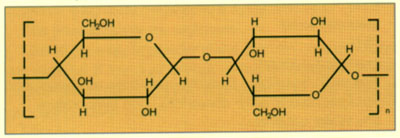
Fig(2):the standard structural duawing of HEC
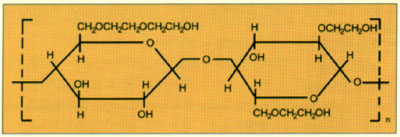
Quality index of HEC
As stated above, HEC is non-ion water-soluble polymer and can tade active effect on thickness-promotion, emulsification, dispersion, stabiliztion, moisture-keeping, film-forming and thus providing protective colloids. HEC is very easy to dissolve in both hot and cold water, viscosity of the solution may vary within a wide range, and high density of elec-trolyte is also acceptable.Fig(1).Quality index of HEC
Nate: (1)Here the weight of 2% water solution is calculated according
to the weight of dried HEC.“S” is attached after the brand No. of the
fast soluble product, for example, FT-6000S refers to TF-6000 as a fast
soluble product, please make clear when ordering.
Merit of using HEC made in Wuxi Sanyou Chemical Co.,Ltd.
1) Easy preperation of solution
A simply equipped stirrer may be used for HEC to dissolve into hot or cold water, the solution may be put into product directly.(2) Excellent compatibility
Since HEC is non-ion chemical, therefore may be used safely while PH value is ranging from 2 to 12, and can present excellent compatibility with other compositional materials such as pigments, additives, salts or electrolytes.(3) Easy operation
Product prepared with HEC is pseudoplastic, therefors possesses excellent evenness while applied, without dropping or waving on surface.(4) Very good film-forming
Since surface tension of product will not be reduced, therefore unnecessary foams will not emerge in production prodcess, at the same time, small holes and needle-like holes will not engender from foams.(5) Stable color
HEC is able to cooperate with various pigmints and solvents in the formulas and make the color more bright and more harmonious.(6) Longer storage period
HEC makes color liquor more stable, thus prolongs storage period, decreases color gradation and separation, and furthermore keeps viscosity stable while timperature varying greatly up and down.
Directions for the use of HEC
Nowadays, three methods are taken as general use.Method A:
Putting in on production directly, the method is most simple and short time is meeded, the precedure is as follows.1. Pour clear water into a big tub fitted with high pressure stirrer
2. At first, keep stiring slowly, then gradually and equally sieve HEC into solution
3. Do not stop stirring until all the granules are fully wetted.
4. Add antimildews and various additives such as pigment dispersing agent, ammonia water etc.
5. Do not put other ingredients of concerned formula and preceed to chemical reaction until all the HEC is thoroughly dissolved (viscosity of the solution is obviously increased)Method B:
Prepare mother liquor for use.
The method is to prepare in advance high density mother liquor, then put it in product. Advantage of the method consists in flexibility, the liquor may be put in product directly, but suitable storage is needed. The procedure is similar to the steps (1)~(4) of the method A, the difference is no need of high pressure stirrer, only such a stirrer is needed as has enough power to keep HEC equally dispersing in solution. And stirring till entirely dissoled into viscouse solution. Please note antimildews must be put into the mother liquor as early as possible.Method C:
Compounding into gruel-like substance for use
Since organic solvents are poor solvents for HEC, therefore these solvents may be used to pripare the gruel-like substance, the most often used organic solvents are ethylene glycol, propyl glycol and filming agent (such as adipic glycol or buty1 carbitol acetate). Ice water is also a poor solvent and hence also often used with organic liquid to prepare the gruel-like substance.The gruel-like HEC may be directly put into product. HEC in gruel-like state has be fully soaked and swelled, when put into product, it dissolves immediately and takes thickness-promotion effect. After putting into,stirring should still be kept until completely dissolved. Usually, the gruel-like substance is a compound of 6 portions of organic solvent and 1 portion of HEC, when compounded for 6-30 minutes, HEC will hydrolyze and swell evidently. Insummer, the water temprature is too high to compound the gruel-like substance.
Points for attention while preparing HEC mother liquor
The surface-treated HEC takes on powder state or fibreshaped solid state, if only pay attention to following matters, the operation will be easy for HEC to dissolve in water.(1) Before and after HEC is put in, unceasingly stirring is needed, until the solution becomes clear enough and completely clarified.(2) Do sieve HEC slowly into the tub, do not directly put large amount of or lumpshaped and ball-shaped HEC into the tub.(3) HEC solubility has much to do with water temperature and its PH value, special attention should be paid to, please see figure(3) and figure (4) for reference.(5) Put in antimildew beforehand as possible as you can.(6) When high density HEC is used, the density of mother liquid should not be higher than 2.5-3%(according to weight), otherwise the mother lequor will be difficult to operate.The aftertreated HEC usually does not conglomerate easily and will not form undissolved ball-shaped colloids after put into water.Figure (3), Relation between dissolution (hydrolysis) speed of TF series HEC and PH value 2% water solution at 25 ℃Rotary viscometer, model NDJ-1
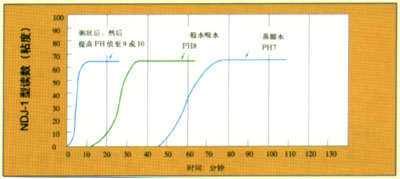
Figure(3), Relarion between dissolution (hydrolysis) speed of TF series HEC and PH value
2% water solution at 25℃
rotary viscometer, model NDJ-1
after becoming gruel-like
PH value increases to 9 or 10
Ordinary water
PH8
Stramed water
PH7
Reading (viscosity)
Figure(4) Relation time(minutes) between dissolution (hydrolysis) speed of TF series HEC and temperature
2% water solution
rotary viscometer, model NDJ, 100rpm
At 50Ё, prepare the gruel-like, them increase PH value to 9, put in antimildew, other alkaline ingredients of aqueous ammonia
Reading
(viscosity)
time (hours)
Figure (4) Relation between dissolution (hydrolysis) speed of TF series HEC and temperature
2% water slution
rotary viscometer, model NDJ,100rpm.
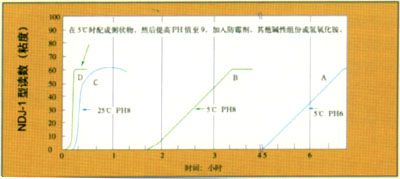
Properties of HEC and its packing
The basic properties are listed in the following table.
Moisture regain:
All models of HEC are absorbent of moisture, moisture held in the ex-factory product is generally controlled below 5%, but environment in trasportation and storage varies, and the moisture held in the prouct increases. When the product is used, measure the moisture, and deduct the moisture weight, do not expose it to the weather.The powder dusts are explosive
Like all the organic powder dusts density in the air reaches certain degree and ignited . Operate properly, do your best bo avoid gendering power dusts.Packing
Packages are two kinds: the simple and the fine.
(1) The simple package is high-pressure polyethylene outside.
(2) The fine package is high-pressure polyethylene polythene inside and corrugated catron drum out side
(3) Net weight 20kg each.
Transport:
As common moisture-tight chemicals
Reference-the application of HEC in emulsion paint
1. Formulas for reference.(1) High-quality outdoor emulsion paint(code
E-1420). Pure acrylic emulsion paint and denatured alkyd resin emulsion
paint are the major.
Properties of emulsion paint product
(2) Indoor emulsion paint (code:l-1258)Ethylence and acrylic acid emulsion
paints are the major
Properties of the emulsion paint
(3) Indoor high-lustre emulsion paint(code:l-1413A)Acrylic acid emulsion
and ethylene-acrylic acid emulsion are the major.
Properties of emulsion paint
3. Factors effecting the viscosity of emulsion paint.(1) The more the
residual air bubbles in paint, the higher the viscosity.(2) Suitable
amount of surface activator versus water.(3) Residual oxide quantity
such as catalyst while compounding emulsion.(4) Proportion of other
natural thickness promoter to HEC.(5) Appropriate procedure putting
in thickness promoter.(6) Excessive stirring sets off overheat while
dispersing.(7) Microoganism erosion on thickness promoter.For details
of above-mentioned factors please apply to our corporation.4. Another
important application of HEC in respect of emulsion-protective colloid
of emulsion polymerization.Apart form being served as stable thickness
promoter, HEC also plays an important role in polymerization of compound
emulsion-protective colloid.Good emulsion paint requires a special paint
theology to ensure fine evenness and eliminate brush trails on the surface
of dried paint film. The theology has to do with the size and distribution
of the emulsion granules, yet the size and distribution have a bearing
on the stabilizer system and polymerization technology adopted in polymerization.The
polymerization caused by using HEC as protective colloids will produce
uniform emulsion quality, without difference in different batchtes of
emulsion; meanwhile the emulsion granule size may be controlled within
a narrow scope and the granules will serve as indispensable materical
for the emulsion polymerization.The emulsion polymerizations which usually
use HEC as the protective colloid include;Vinyl acetate and other copolymerizing
monomers such as acrylic resin, butadiene resin; para-butadiene resin,
ethylene etc. methyl acrylic resin and other coplymerizing monomers
such as acrylate, butadiene etc.Styrene-acrylate copolymer, styrene-butadiene
coplymer, vinyl chloride-acrylate copolymer, acrylonitrile-butadiene
copolymer.For detail techmological data please apply to Wuxi SanyouChemical
Co.,Ltd.The aforesaid data and recommended formulas are drawn up on
the basis of the manual of the USA United Carbon Chemical Company (UCC)
and only for your reference.
HEC consists of two parts, one is cellulose, the other is hydroxyethyl side chain, HEC itself does not dissolve in water and is composed of numerous monose units, as illrstrated in figure(1), reaction of purified cellulose with sodium hydroxide produces alkaline cellulose colloids, put epoxyethane ito the colloide, HEC can be obtained. Since a monose unit of cellulose contains 3 hydroxies, the maximum replacement value should be 3. Nowaday, the replacement value of HEC is controlled between 1 and 2 on average, at the same time, the applied amount of epoxyethane is also controlled at 2 grammoles versus a monose unit, that is to say, on average one monose unit reacts with 2grammoles of epoxyethane, which may be joined togegher, a head with another’s tail, and then connected to a hydoxy or to two hydroxides respectively, as illustrated in figure(2)Fig(1):the structural drawing of collulose.

Fig(2):the standard structural duawing of HEC

As stated above, HEC is non-ion water-soluble polymer and can tade active effect on thickness-promotion, emulsification, dispersion, stabiliztion, moisture-keeping, film-forming and thus providing protective colloids. HEC is very easy to dissolve in both hot and cold water, viscosity of the solution may vary within a wide range, and high density of elec-trolyte is also acceptable.Fig(1).Quality index of HEC
| specifictionbrand No | Appe-arance | Gram-mole repla- cement value (m·s) |
mois-ture(%) | indiss- olubility (%) |
Pervio-usness of light(2%) | NDJ-1 rotary viscometer mPa.s 2% 20℃ water solution | ||
| Viscosity range | Spindle No. | Rotary speed of spindle | ||||||
| TF-50S | powder | 1.8-2.0 | <6 | <0.5 | ≥80 | <100 | 1 | 30 |
| TF-1000S | powder | 1.8-2.0 | <6 | <0.5 | ≥80 | 800-1200 | 2 | 12 |
| TF-6000S | powder | 1.8-2.0 | <6 | <0.5 | ≥80 | 4000-7000 | 3 | 12 |
| TF-10000S | powder | 1.8-2.0 | <6 | <0.5 | ≥80 | 8000-12000 | 3 | 6 |
| TF-15000S | powder | 1.8-2.0 | <6 | <0.5 | ≥80 | 13000-17000 | 3 | 6 |
| TF-20000S | powder | 1.8-2.0 | <6 | <0.5 | ≥80 | 18000-24000 | 4 | 12 |
| TF-30000S | powder | 1.8-2.0 | <6 | <0.5 | ≥80 | 26000-34000 | 4 | 12 |
| TF-40000S | powder | 1.8-2.0 | <6 | <0.5 | ≥80 | 36000-44000 | 4 | 12 |
| TF-60000S | powder | 1.8-2.0 | <6 | <0.5 | ≥80 | 55000-65000 | 4 | 6 |
| TF-70000S | powder | 1.8-2.0 | <6 | <0.5 | ≥80 | 66000-74000 | 4 | 6 |
| TF-80000S | powder | 1.8-2.0 | <6 | <0.5 | ≥80 | 75000-83000 | 4 | 6 |
1) Easy preperation of solution
A simply equipped stirrer may be used for HEC to dissolve into hot or cold water, the solution may be put into product directly.(2) Excellent compatibility
Since HEC is non-ion chemical, therefore may be used safely while PH value is ranging from 2 to 12, and can present excellent compatibility with other compositional materials such as pigments, additives, salts or electrolytes.(3) Easy operation
Product prepared with HEC is pseudoplastic, therefors possesses excellent evenness while applied, without dropping or waving on surface.(4) Very good film-forming
Since surface tension of product will not be reduced, therefore unnecessary foams will not emerge in production prodcess, at the same time, small holes and needle-like holes will not engender from foams.(5) Stable color
HEC is able to cooperate with various pigmints and solvents in the formulas and make the color more bright and more harmonious.(6) Longer storage period
HEC makes color liquor more stable, thus prolongs storage period, decreases color gradation and separation, and furthermore keeps viscosity stable while timperature varying greatly up and down.
Directions for the use of HEC
Nowadays, three methods are taken as general use.Method A:
Putting in on production directly, the method is most simple and short time is meeded, the precedure is as follows.1. Pour clear water into a big tub fitted with high pressure stirrer
2. At first, keep stiring slowly, then gradually and equally sieve HEC into solution
3. Do not stop stirring until all the granules are fully wetted.
4. Add antimildews and various additives such as pigment dispersing agent, ammonia water etc.
5. Do not put other ingredients of concerned formula and preceed to chemical reaction until all the HEC is thoroughly dissolved (viscosity of the solution is obviously increased)Method B:
Prepare mother liquor for use.
The method is to prepare in advance high density mother liquor, then put it in product. Advantage of the method consists in flexibility, the liquor may be put in product directly, but suitable storage is needed. The procedure is similar to the steps (1)~(4) of the method A, the difference is no need of high pressure stirrer, only such a stirrer is needed as has enough power to keep HEC equally dispersing in solution. And stirring till entirely dissoled into viscouse solution. Please note antimildews must be put into the mother liquor as early as possible.Method C:
Compounding into gruel-like substance for use
Since organic solvents are poor solvents for HEC, therefore these solvents may be used to pripare the gruel-like substance, the most often used organic solvents are ethylene glycol, propyl glycol and filming agent (such as adipic glycol or buty1 carbitol acetate). Ice water is also a poor solvent and hence also often used with organic liquid to prepare the gruel-like substance.The gruel-like HEC may be directly put into product. HEC in gruel-like state has be fully soaked and swelled, when put into product, it dissolves immediately and takes thickness-promotion effect. After putting into,stirring should still be kept until completely dissolved. Usually, the gruel-like substance is a compound of 6 portions of organic solvent and 1 portion of HEC, when compounded for 6-30 minutes, HEC will hydrolyze and swell evidently. Insummer, the water temprature is too high to compound the gruel-like substance.
The surface-treated HEC takes on powder state or fibreshaped solid state, if only pay attention to following matters, the operation will be easy for HEC to dissolve in water.(1) Before and after HEC is put in, unceasingly stirring is needed, until the solution becomes clear enough and completely clarified.(2) Do sieve HEC slowly into the tub, do not directly put large amount of or lumpshaped and ball-shaped HEC into the tub.(3) HEC solubility has much to do with water temperature and its PH value, special attention should be paid to, please see figure(3) and figure (4) for reference.(5) Put in antimildew beforehand as possible as you can.(6) When high density HEC is used, the density of mother liquid should not be higher than 2.5-3%(according to weight), otherwise the mother lequor will be difficult to operate.The aftertreated HEC usually does not conglomerate easily and will not form undissolved ball-shaped colloids after put into water.Figure (3), Relation between dissolution (hydrolysis) speed of TF series HEC and PH value 2% water solution at 25 ℃Rotary viscometer, model NDJ-1

Figure(3), Relarion between dissolution (hydrolysis) speed of TF series HEC and PH value
2% water solution at 25℃
rotary viscometer, model NDJ-1
after becoming gruel-like
PH value increases to 9 or 10
Ordinary water
PH8
Stramed water
PH7
Reading (viscosity)
Figure(4) Relation time(minutes) between dissolution (hydrolysis) speed of TF series HEC and temperature
2% water solution
rotary viscometer, model NDJ, 100rpm
At 50Ё, prepare the gruel-like, them increase PH value to 9, put in antimildew, other alkaline ingredients of aqueous ammonia
Reading
(viscosity)
time (hours)
Figure (4) Relation between dissolution (hydrolysis) speed of TF series HEC and temperature
2% water slution
rotary viscometer, model NDJ,100rpm.

The basic properties are listed in the following table.
| Item | Index | |
| 1 | appearance | White, light yellow, fibre or powder, solid state. |
| 2 | Surface density g/ml | 0.35~0.61 |
| 3 | Specific gravity (film 20%/20℃) | 1.38~1.41 |
| 4 | dioptre(film n.20) | 1.51 |
| 5 | Softening temperature ℃
|
135 ~140 |
| 6 | Decomposing temperatu ℃ | 205~210 |
| 7 | Combustion speed | slow |
| 8 | Grammole replacement value | 1~2 |
| 9 | Viscosity(2%、20℃、mPa.s) | tens to ten thousands |
| 10 | volatility(w/w) | ≤ 5% |
| 11 | ash(according to Na2CO3) | ≤ 6% |
| 12 | PH | 6~7 |
| 13 | Density(g/ml) | 0.55~0.75 |
| 14 | Granule size | Mesh No40,sieved-through rae≥90% |
| 15 | Surface tension(0.01~0.1% )Water solution,25 ℃ | 60~65 dynets/cm |
| 16 | Static electricity | no |
| 17 | dissolubility | Soluble in cold, hot water, acid, alkaly;insoluble in most organic solvents. |
All models of HEC are absorbent of moisture, moisture held in the ex-factory product is generally controlled below 5%, but environment in trasportation and storage varies, and the moisture held in the prouct increases. When the product is used, measure the moisture, and deduct the moisture weight, do not expose it to the weather.The powder dusts are explosive
Like all the organic powder dusts density in the air reaches certain degree and ignited . Operate properly, do your best bo avoid gendering power dusts.Packing
Packages are two kinds: the simple and the fine.
(1) The simple package is high-pressure polyethylene outside.
(2) The fine package is high-pressure polyethylene polythene inside and corrugated catron drum out side
(3) Net weight 20kg each.
Transport:
As common moisture-tight chemicals
| PIGMENT LIQUOR INGREDIENTS | Pure acrylic acid emulsion paint | Denatured alkyd resin emulsion paint | ||
| Weight(pound) | Volume(gallon) | Weight(pound) | Volume(gallon) | |
| water | 277.0 | 33.3 | 227.0 | 33.3 |
| HEC TF-15000S | 4.6 | 0.4 | 4.6 | 0.4 |
| Foam eliminant | 1.0 | 0.1 | 1.0 | 0.1 |
| Dispersing agent | 8.5 | 0.9 | 8.5 | 0.9 |
| KTTP | 1.0 | / | 1.0 | / |
| Ethylene glycol | 25.0 | 2.7 | 25.0 | 2.7 |
| Antiseptic agent | 2.0 | 0.2 | 2.0 | 0.2 |
| TERGITOL NP-10 | 2.5 | 0.3 | 2.5 | 0.3 |
| Zinc oxide | 50.0 | 1.1 | 50.0 | 1.1 |
| Titanium white | 225.0 | 6.5 | 225.0 | 6.5 |
| clay | 150.0 | 7.0 | 150.0 | 7.0 |
Other INGREDIENTS
| activator | / | / | 20 | 0.2 |
| Alkyd resin(treated with drier) | / | / | 27.4 | 3.3 |
| UCAR acrylic acid emulsion 515 | 410.0 | 44.9 | 348.0 | 38.0 |
| water | / | / | 32.5 | 3.9 |
| Buty1 Carbitol | 15.0 | 1.9 | 13.0 | 1.6 |
| Mildewcide | 2.0 | 0.2 | 2.0 | 0.2 |
| 28% ammonia water | 3.0 | 0.4 | 2.0 | 0.2 |
| Foam eliminant | 1.0 | 0.1 | 1.0 | 0.1 |
| total | 1177.6 | 100.0 | 1174.5 | 100.0 |
| composition | Pure acrylic emulsion paint | Denatured alkyd resin emulsion paint |
| Pigment velume concentration(PVC) | 10% | 40% |
| Denatured amount of alkyd resin | 0% | 15% |
| Solid content(according to volume) | 36.5% | 36.5% |
| (According to weight) | 54.5% | 54.2% |
| PH | 9.0 | 9.0 |
| Viscosity Stormer reading | 85KU | 95KU |
| Viscosity Brusnometer reading | 1.1泊 | 1.0泊 |
| composition | Weight(pound) | Volume(gallon) |
| water | 400.0 | 48.2 |
| HEC TF-6000S | 5.0 | 0.4 |
| Dispersing agent | 6.0 | 0.7 |
| TERGITOL XP-10 | 2.0 | 0.2 |
| Ethylene glycol | 15.0 | 1.6 |
| Buty1 Carbitol acetatef | 10.0 | 1.3 |
| Foam eliminant | 4.0 | 0.5 |
| Antiseptic agent | 0.5 |
|
| Titanium white | 250.0 | 7.1 |
| Calcium carbonate(rutile) | 125.0 | 5.5 |
| Clay | 75.0 | 3.5 |
| Porcelain clay | 50.0 | 2.1 |
| UCAR 366 ethyleneand acrylic acid emulsion | 260.0 | 28.9 |
| Tatol | 1202.5 | 100.0 |
| Pigment volume concentration(PVC) | 55% |
| Solid content(weight) | 54% |
| Veight for a gallon | 12 pounds |
| Viscosity (Stormer) | 85-88KU |
| Pigment liguor INGREDIENTS | Weight(pound) | Volume (gallon) |
| water | 150.0 | 18.01 |
| Polypropylene glycol | 40.0 | 4.63 |
| HEC TF-15000S | 2.5 | 0.23 |
| Dispersing agent | 9.0 | 0.97 |
| Butyl carbitol acetate | 25.0 | 3.15 |
| Foam eliminant | 1.0 | 0.13 |
| Tergitol NP-40 | 4.0 | 0.40 |
| Antiseptic agent | 1.0 | 0.13 |
| Titanium white | 250.0 | 7.27 |
| water | 50.0 | 6.00 |
| Moistening agenmt | 2.0 | 0.24 |
| UCAR 503 acrylic acid emulsion | 420.0 | 45.67 |
| Foam eliminant | 1.5 | 0.20 |
| Water or concocted water with thickness-promoting agent | 104.0 | 12.50 |
| 28% ammonia water | 3.6 | 0.45 |
| total | 1063.6 | 99.98 |
| Pigment volume concentration(PVC) | 23.0% |
| Solid content, according to volume | 31.6% |
| Solid content, according to weight | 46.6% |
| Weight per gallon | 10.6磅 |
| Viscosity (Stormer) | 85.0K |
| Film luster, angle 600 | 85 |
2. Guide to selecting viscosity model of HEC
| Type of EP (emulsion paint) | Brand code of viscosity
|
Main function in paint |
| Low price EP | TF-40000S TF-30000S |
Less thichness-promoting agent, low cost |
| Common indoor EP | TF-6000S TF-10000S TF-15000S |
Balande each property of paint such as evenness, stability, color,antiattrition, suspension flowage etc. |
| Common outdoor EP | TF-6000S TF-10000S TF-15000S |
Good stability, keeping pigment in suspension, resistence to rain |
| Omni-lustre or semi-luster EP | TF-6000S TF-10000S TF-15000S |
Good evenness |
| Embossing EP | TF-15000S TF-30000S |
Froming stable bigger colloid granules. |

